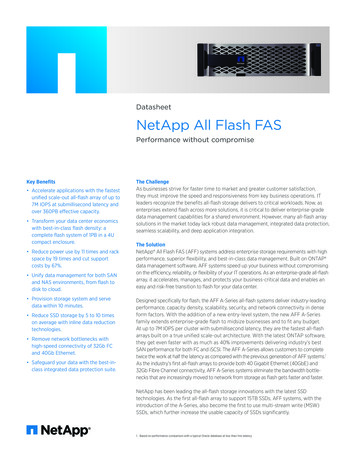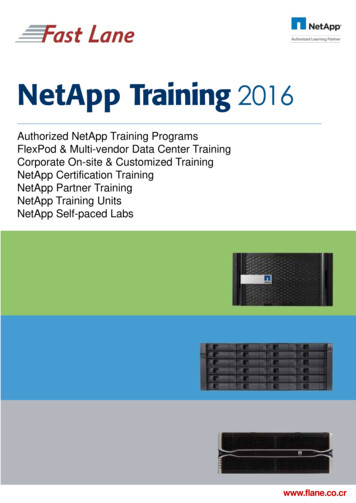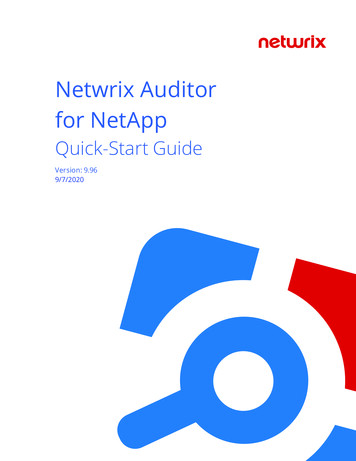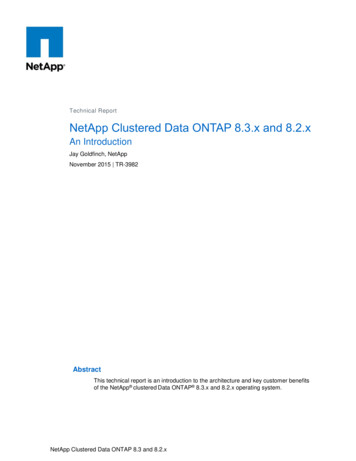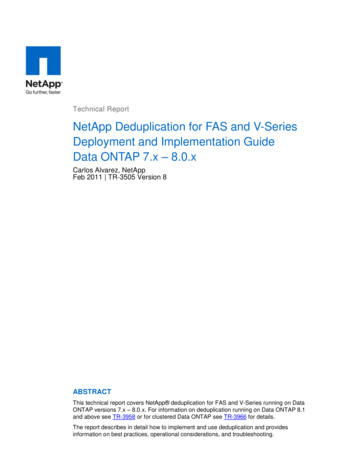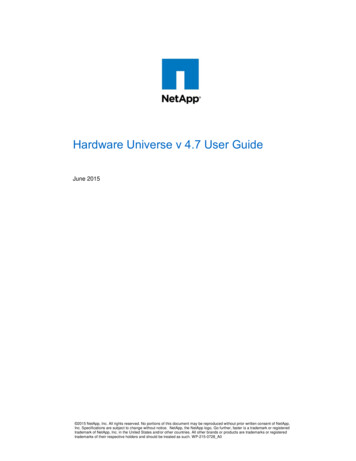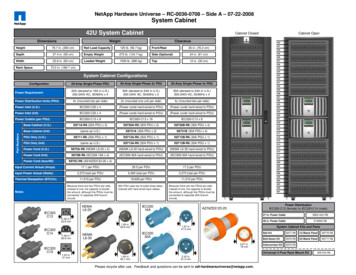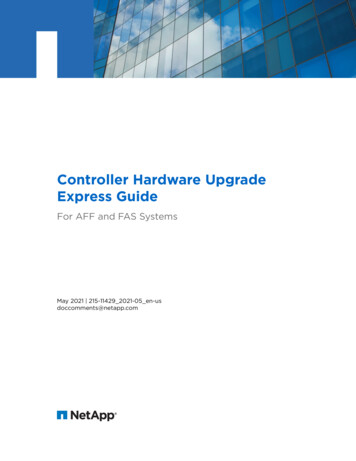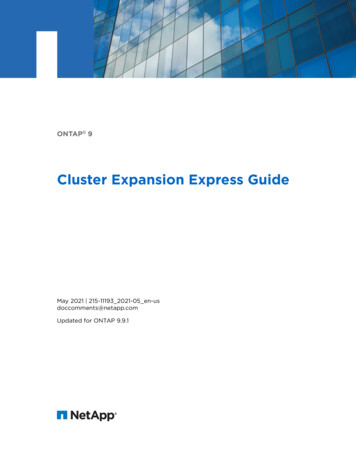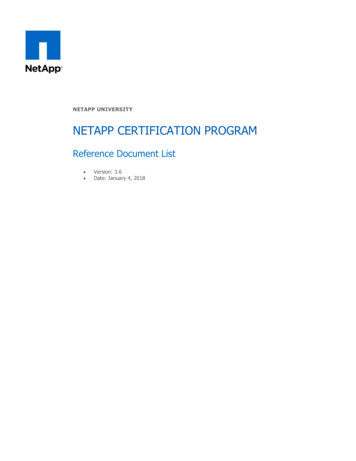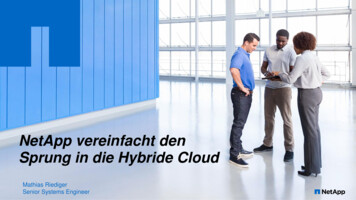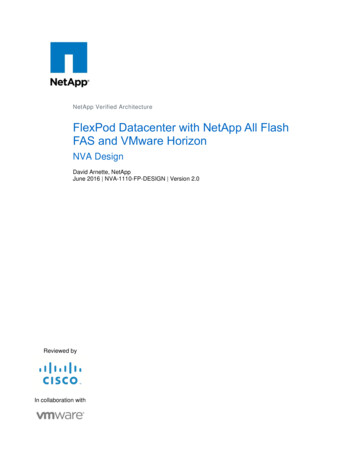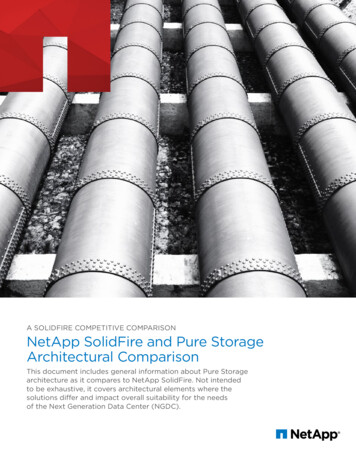
Transcription
A SOLIDFIRE COMPETITIVE COMPARISONNetApp SolidFire and Pure StorageArchitectural ComparisonThis document includes general information about Pure Storagearchitecture as it compares to NetApp SolidFire. Not intendedto be exhaustive, it covers architectural elements where thesolutions differ and impact overall suitability for the needsof the Next Generation Data Center (NGDC).
OverviewThe FlashArray series from Pure Storage is an all-flash, dual-controllerstorage solution, based on a traditional active/passive scale-uparchitecture, where capacity is scaled by adding additional driveshelves to a pair of controllers and performance is scaled by replacingthe controllers with more powerful controller models.Architectures based on storage controller pairs, also referredto as storage node pairs, have been the standard for enterpriseblock storage for many years. Enterprise familiarity, standarddesign concepts, and fast time-to-market are some of thekey reasons Pure Storage designed its FlashArray off thisfamiliar architecture. Unfortunately, dual-controller, scale-uparchitectures are not without their caveats, and with all-flashstorage, many of those caveats become limitations.The intention of Pure’s FlashArray was to replace traditionalblock storage arrays with a similar architecture, the differencesbeing that it has been designed and optimized specifically forflash with a focus on low latency. This approach not only enablesPure to directly replace legacy spinning disk with all-flashstorage but also addresses application performance complaintscommon to block storage. While Pure has been successful atimplementing key functionality such as in-line efficiencies,its focus on latency performance and fitting into the existingblock storage paradigm has kept it from addressing the issue ofscaling a traditional architecture and providing a way to controlhow flash performance is delegated to application workloads.The resultant solution from Pure is one well suited for highperformance, single-point solutions, but it is not a good fit formixed workloads and solutions where very large performanceand capacity scale is desired.This document compares the architectural elements of thePure FlashArray with NetApp SolidFire all-flash solutions andassesses their suitability for the needs of the Next GenerationData Center (NGDC). NetApp recommends evaluating all-flashstorage solutions based on application requirements and offersa portfolio of solutions tailored to different environments,including: SolidFire SF-series systems with Element OS software;All- Flash FAS systems with ONTAP software; and EF-Seriessystems with SANtricity software.FindingsAs a high performance alternative to traditional block storagepoint solutions, Pure Storage’s solutions offer high performanceand an implementation familiar to the industry. The active/passive controller-centric architecture provides a familiar lookto a block storage solution but carries with it many of thetraditional drawbacks found in a dual-controller architecture,limiting its ability to enable a next generation data center.Specifically Agile - SolidFire enables enterprises to cost-effectivelysupport specific solutions and adapt on the fly to multipleworkload environments without affecting the performanceof existing applications. Likewise, SolidFire’s shared-nothingarchitecture allows for the addition or removal of any modelof cluster node, 1U at a time, on the fly while maintainingapplication-specific Quality of Service (QoS) with maximum,minimum, and burst IOPS settings independent of capacity.Pure solutions offer scale up of capacity but only to a point of 400TB of effective capacity depending on the model of controllersin the individual implementation. The //m10, //m20, //m50, andm70 models each scale up through the addition of external driveshelves to offer claimed effective capacities of which Pure refersto as usable capacities of 12.5-25 TBs, 15-120 TBs, 60-250 TBs,and 150-400 TBs, respectively. After implementation, any needto scale beyond (above or below) one of the capacity ranges hashistorically required a disruptive “forklift” controller swap-out. Withthe new //m series, Pure claims that is no longer the case. Scalability - Pure’s solutions follow a traditional controller-centricsolution limiting the current usable capacity of deployments to400 TB and tiered rather than linear scaling of performance.Pure’s location- vs. content-addressed architecture, used inmapping content to a specific location on disk, means thatexpansion and/or movement of data are significantly moreoverhead-intensive as the array fills, negatively affecting theperformance and manageability at scale. Guaranteed - A key requirement of the next generationdata center is to have an environment based on repeatable,predictable performance. Designed to get to the marketquickly with an all-flash replacement to traditional blockstorage, Pure solutions offer good speed with low latency butdo not have the ability to specify QoS for individual volumes,meaning applications and users can experience inconsistentperformance in multiple parallel workload environments.SolidFire enables enterprises to specify and guaranteeminimum, maximum, and burst IOPS for individual storagevolumes on the fly, independently of capacity, eliminating the“noisy neighbor” problem in mixed workload environments. Automated - Both SolidFire and Pure Storage have APIs forautomating storage management, but only SolidFire offersthe ability to automate every storage function of the arrayfrom the API. With SolidFire, data availability is also highly automated. Inthe unlikely event of a SolidFire node or multiple node failures,SolidFire automatically rebalances the lost node’s data acrossall remaining nodes, restoring complete redundancy whilemaintaining all guaranteed QoS settings. As an added bonus,performance of SolidFire’s rebalance improves as more nodesare added to the cluster!Pure’s dual controllers, on the other hand, are deployed in anactive/passive configuration. When a controller experiences afailure, the deployment fails over to the backup controller. Thenow-active controller becomes a single point of failure until thefailing controller is manually replaced.
SolidFire vs. Pure StorageData addressing/managementBoth SolidFire and Pure use a log-structured approach inwriting to disk. This optimizes utilization and performance ofSSDs, significantly improves the lifespan of SSDs, and, mostimportantly, enables the use of less expensive consumer-gradeMLC SSDs.The log-structured approach, or reading in of current valid dataand new data and writing it to disk in a linear fashion, in essenceaggregates many small writes into a large write. Compared to afixed-block approach, the log-structured approach significantlysimplifies supporting compression and variable block sizes.One area where Pure and SolidFire architectures differ isPure relies on the layering of metadata for functionality likededuplication, snapshots, and clones. The architecture beginswith a location-addressing schema, as opposed to SolidFire’scontent-addressing technique, using a logical unit number (LUN)and logical block address (LBA) to tag a specific piece of datato a physical location in the array. Layered on top of this basekey-value store, additional tables of block-checksum values, linkvalues, and shared block-value tables are maintained to compareincoming data against and/or to map multiple reference pointersfor deduplication, snapshots, and clones.Differences between Pure’s location-addressing architectureand SolidFire’s content-addressing architecture In the Pure architecture all of the metadata is stored on SSDs andpartially cached (as opposed to 100% at runtime for SolidFire).The net result of this tradeoff is an average of 50% (1.5 to 1)cache-miss ratio. This can lead to somewhat inconsistent readperformance, particularly as the array begins to fill up. Any time data is moved within the array (as is frequentlydone in storage systems), the primary data structure mustbe updated. In SolidFire’s content-addressing system, on theother hand, the content ID does not change, and thus there isno need for I/O intensive updates. Because of the need for tight coupling between multiple layersof metadata, Pure’s content-addressing architecture workswell in a tightly coupled dual-controller architecture but wouldnot be well-suited for global deduplication.Quality of ServiceClearly, Pure’s all-flash systems are fast arrays with consistentlylow latency. However, Pure provides no Quality of Service (QoS)or performance provisioning to ensure all applications in mixedworkload deployments consistently get the IOPS they need,and are protected from unpredictable application I/O usagesuch as noisy neighbor scenarios. Without QoS, large-scaleinfrastructure customers and/or those looking to consolidatemultiple applications onto a single platform may find they haveto buy more Pure Storage arrays or larger controllers to provideinsurance against application performance variability.Figure 1: SolidFire QoSSolidFire architectureallows users to setminimum, maximum,and burst IOPS on aper-volume basis.To deliver predictable and guaranteed storage performance,SolidFire leverages QoS performance virtualization of resources.Patented by SolidFire, this technology permits the managementof storage performance independently from storage capacity.SolidFire architecture enables the capability to set minimum,maximum, and burst IOPs on a per-volume basis. Becauseperformance and capacity are managed independently, SolidFireclusters are able to deliver predictable storage performance tothousands of applications within a shared infrastructure.ScalingSolidFire’s clustered architecture enables the linear scale out ofcapacity and performance as nodes are added to the system,meaning each additional node provides a predictable amount ofperformance. This also means scaling up to 3.4 PBs of effectivecapacity and a potential 7.5M guaranteed IOPS.Pure’s use of a scale-up architecture means a Pure Storagearray’s performance and ability to scale capacity is basedcompletely on the capabilities of the controllers in use. Increasingperformance or capacity beyond the controller limit requiresnew, more powerful controllers or the deployment of a new PureStorage array.Controllers are deployed in an active/passive pair. Under normaloperating conditions (i.e. without a controller issue/failure),only one of the controllers is active at any time and the secondbecomes active only in the event of a failure of the primary.Figure 2: SolidFire Mixed-Node Scale-OutAt any point during or after deployment, nodes can be added, removed,or replaced to increase capacity and/or performance without impactingexisting workloads. As nodes are added, their capacity and IOPS areaggregated into the total provisionable capacity and performanceavailable for assignment to any existing or new volume.
Positive aspects of Pure scaling model: Capacity can be scaled independently of performance Performance is “consistent” (excluding cache-miss variations)in the event of a controller or disk failure Top-end performance with a relatively small amount of capacityFigure 3: Pure Scale-Up vs. Scale-OutIn Pure’s architecture, performance increases are achieved by means ofa controller upgrade. Pure Storage claims its current largest array scalesup to about 400 TB of usable capacity with 300,000 32k IOPS in 11U ofrack space.Potential negative aspects of Pure’s scaling model: Performance upgrade is only possible by upgrading controllers Unplanned controller upgrades can be required if performanceor capacity limits are reached Large environments may require deployment of multiplesiloed arraysData assurancePurePure’s solutions use a traditional shared-controller model.Historically with this type of architecture, the redundancy liveswith the disk shelf in the form of dual-ported drives and redundantback planes. Due to cost considerations, dual-drive ports are notavailable for solid-state drives or included in Pure’s design.In the event of a Pure disk-shelf failure, RAID groups notstriped across multiple shelves will be lost. Use of RAID for dataprotection means, at best Pure will experience longer driverebuild times than SolidFire as the array fills up. At worst, acascading drive failure could result.As mentioned earlier in the I/O pathway comparison, the PureStorage dual controllers are deployed in an active/passiveconfiguration. At any one time when a controller experiences afailure, the deployment defaults to the backup controller. The nowactive controller becomes a single point of failure until the failedcontroller is replaced.SolidFireWith SolidFire’s RAID-less approach, there is no sharing of anyhardware component in the system. Connectivity between thenodes is redundant, and the design is such that anything in thecluster can fail — any piece of hardware, any software process,any network component — and the system will continue running.In the event of a node or multiple node failures, SolidFire automaticallyrebuilds redundant data across remaining nodes in minutes, restoringcomplete redundancy while maintaining all guaranteed QoS settings.Efficiency and data integrity: Helix vs. RaidRAID is commonly promoted as an advantage by other shared-diskflash architectures because it is very easy to implement dual-parityprotection with acceptable capacity overhead. It is importantto remember that in the SolidFire design, the shared nothingarchitecture means each node is a fully functional unit, removing theoverhead (cost, management, and footprint) of shared controllers.SolidFire Helix takes advantage of this distributed architecture byproviding an exact copy of all data in the cluster, so if a drive fails therebuild process simply reconstructs the data that was on that drivebased on the copy. Since the rebuild is simply copying the data fromother drives in the cluster, rebuild times are extremely fast, there isfar less wear and tear on drives, and there is no RAID overhead toimpede the large scale common to scale-out clusters.Another benefit of Helix and the SolidFire architecture is thatin addition to drive failures, Helix can automatically recoverfrom an entire node failure, enabling the nondisruptive additionor removal of nodes to/from an active cluster. When a nodefails or is added to or removed from the cluster, the process ofrebalancing is exactly the same as that of a drive. The advantageof SolidFire Helix is that the entire cluster takes part in therebalancing, and everything happens automatically. This resultsin a very fast rebuild with very minimal performance impact and,most importantly, the elimination of any single point of failure.Comparing SolidFire’s self-healing approach to Pure’s traditionalRAID striping, it quickly becomes apparent that SolidFire offersflexibility and protection not found with Pure Storage. In the eventof a node failure in a Pure array, the array is in a single-point-offailure scenario until the failed node is physically removed. Pure isalso unable to add or remove nodes to an array nondisruptively,limiting Pure to dual-controller silos within the data center.ABEABECDCDFigure 5: SolidFire HelixAutomated Mesh RedundancyWhen a drive fails, the rebuildprocess reconstructs the data thatwas on that drive and restores theredundancy in the system.
The bottom linePure Storage offers all-flash solutions built upon the traditionalcontroller-centric, RAID-based architecture many organizations areaccustomed to. Pure has been successful at providing a solutionthat brings the performance benefits of flash to these traditionalblock storage customers. Like traditional scale-up solutions, Pure’sarchitecture is well suited for point-solution environments but isless than optimal in the areas of scale, automation, QoS, and agilityfor next generation data center applications, including large scalemultiple/mixed workload and IT as a Service (ITaaS) deployments.SolidFire’s shared-nothing, scale-out architecture makes it ideallysuited for large-scale, mixed-workload enterprise and serviceprovider deployments. The ability to mix multiple models of nodeswithin clusters, scaling out performance and capacity linearly atany time (not just at initial deployment), combined with the abilityto guarantee IOPS per volume means deployments can start andgrow as needed without disruption to running applications orworry of stranding either performance or capacity.SolidFire’s architecture means organizations can consolidatemultiple applications and workloads onto an agile, scalable,predictable, and automated, infrastructure. The flexibility ofthe SolidFire architecture ultimately saves customers timeand money, resulting in a much lower infrastructure TCO and,consequently, a healthier bottom line. 2016 NetApp, Inc. All rights reserved. No portions of this document may be reproduced without prior written consent of NetApp, Inc. Specifications are subject to changewithout notice. NetApp, the NetApp logo, SolidFire, and SolidFire Helix are trademarks or registered trademarks of NetApp, Inc. in the United States and/or other countries. Allother brands or products are trademarks or registered trademarks of their respective holders and should be treated as such. A current list of NetApp trademarks is available onthe web at http://www.netapp.com/us/legal/netapptmlist.aspx. WP-7228-0516
m70 models each scale up through the addition of external drive . storage, Pure solutions offer good speed with low latency but do not have the ability to specify QoS for individual volumes,
